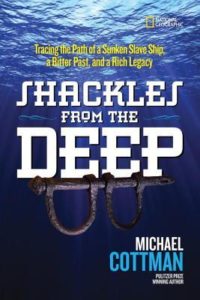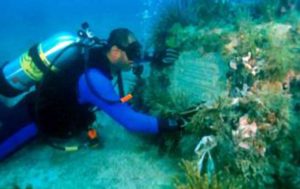“Journey” by Michael Cottman
My journey to write Shackles From The Deep started when I was a boy growing up in Detroit and watching a popular television show called Sea Hunt, a 1960s adventure program about an underwater detective.
From the time I was a kid, I wanted to scuba dive and explore the ocean’s depths. And because National Geographic embraces adventure tales like no other company, this was a perfect publishing partnership.
I wrote Shackles From The Deep in a conversational way for young readers to share the story of the Henrietta Marie, a sunken 17th century slave ship. This is more than just the story of one ship – it’s the untold story about millions of African people taken as captives to the New World.
I traveled to three continents to piece together a trans-Atlantic puzzle. I reviewed shipping records and slave-ship captain’s logs in London. I retraced the route of the Henrietta Marie slave ship and scuba-dived the ship’s ports of call in Jamaica, Barbados, and West Africa.
During my research, I learned amazing things: Today, the Henrietta Marie is believed to be the world’s largest source of tangible objects from the early years of the slave trade.
The Henrietta Marie is the only slave ship in America that has been scientifically documented and where more than 20,000 artifacts were recovered, including the largest collection of slave-ship shackles ever found on one site.
I also learned the shackles were discovered in 1973 by Moe Molinar, a black underwater treasure hunter who was searching for the Atocha, a Spanish galleon that had sunk nearly 400 years ago filled with gold, silver and $400 million worth of jewels.
Treasure hunters didn’t know what to make of these relics. Then in 1983, maritime archaeologists, intrigued by the mystery, revisited the site and came upon a ship’s bell. As they chipped away at the limestone encrustation a name and a date emerged: Henrietta Marie, 1699.
Beneath the sea, on the wreck of the Henrietta Marie, I ran my hands through the sand and held the tiny glass trade beads that were used by the Henrietta Marie’s crew to trade for African people.
The story of Shackles From The Deep also introduces young readers to the unprecedented partnership between members of The National Association of Black Scuba Divers (I’m a lifetime member) and white maritime archaeologists who explored the Henrietta Marie together for a common purpose and forged lifelong friendships along the way.
After all, the global institution of slavery is our collective history.
But because of slavery, it is nearly impossible for African Americans to pinpoint the origins of our ancestors.
We cannot always identify a country in Africa where they were born, let alone a city or village. We can only know they came from somewhere on the west coast of the enormous continent.
Are my people Ibo from Nigeria, or Fulani from Mali, or Wolof from Senegal, or Ashanti from Ghana? I may never know.
What’s important, however, is my appreciation for the African culture — my culture, too — and my need to draw strength from the African people who came before me and survived.
And we continue to honor them.
In 1993, I joined members of The National Association of Black Scuba Divers to place a one-ton concrete memorial on the site of the Henrietta Marie shipwreck.
The bronze inscription on the memorial is a powerful testament to the human spirit: “In memory and recognition of the courage, pain and suffering of enslaved African people. Speak her name and gently touch the souls of our ancestors.”
Shackles from the Deep: Tracing the Path of a Sunken Slave Ship, a Bitter Past, and a Rich Legacy
Author: Michael Cottman
Published January 3rd, 2017 by The National Geographic Society
Summary: A pile of lime-encrusted shackles discovered on the seafloor in the remains of a ship called the Henrietta Marie, lands Michael Cottman, a Washington, D.C.-based journalist and avid scuba diver, in the middle of an amazing journey that stretches across three continents, from foundries and tombs in England, to slave ports on the shores of West Africa, to present-day Caribbean plantations. This is more than just the story of one ship it’s the untold story of millions of people taken as captives to the New World. Told from the author’s perspective, this book introduces young readers to the wonders of diving, detective work, and discovery, while shedding light on the history of slavery.
Critical Praise:
“The idea of identity is at the center of this fascinating narrative nonfiction book…This truly multidisciplinary volume….engagingly explores a wide scope of topics, including the history of slavery, marine archaeology, and contemporary racial discrimination, culminating in a dive down to the wreck itself. Every bit of this concise, detailed book feels personal, and Cottman’s exploration and investigation of the wreck is rich with intrigue and poignant, thought-provoking questions.” -Booklist (STARRED REVIEW)
“Cottman weaves his personal story of discovery with history of the slave trade, helping readers understand why a sunken slave ship from the 1700s still matters. His emotional attachment to the artifacts, including child-sized shackles, deepens the storytelling in this highly readable narrative.” –Kirkus
“Accessible and very personal account….(a) chilling exploration of the slave trade.” -Publishers Weekly
“Cottman’s personal journey, fraught with reminders of the trials and injustice his own enslaved ancestors must have endured, is compelling” -BCCB
About the Author: Michael H. Cottman, Pulitzer Prize-winning journalist and author, is a former political reporter for the Washington Post. Cottman has appeared on National Public Radio’s (NPR) “Tell Me More” with Michel Martin and also the Oprah Winfrey Show in 2000 to discuss his (adult) book The Wreck of the Henrietta Marie. Cottman also serves as a special consultant to the National Oceanic Atmospheric Administration (NOAA) for a national multimedia project, “Voyage to Discovery,” an education initiative that focuses on the African-American contribution to the maritime industry spanning 300 years and efforts to teach students of color about careers in marine biology and oceanography. Visit his website at http://www.michaelhcottman.com/.
Thank you to Michael for his post and to Barbara from Blue Slip Media for providing the resources!



